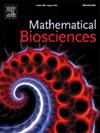抗血管内皮生长因子和肿瘤细胞毒性治疗的数学研究。
IF 1.8
4区 数学
Q2 BIOLOGY
引用次数: 0
摘要
本文研究了抗血管生成治疗和化疗两种癌症治疗方法,并提出了一种新的数学模型和相关的最优控制问题。该模型包括肿瘤细胞、内皮细胞、免疫细胞和血管内皮生长因子(VEGF),其中抗血管生成治疗仅针对VEGF,化疗不分青红皂白地杀死所有细胞。最优控制问题使肿瘤负荷和药物毒性在一组时变药物剂量上最小化。数学分析证明了模型在所有治疗策略上的正不变集的存在性、多个稳态解的稳定性以及最优控制解的存在唯一性。分析和模拟得出了几个重要的发现。首先,在抗vegf治疗下,所有肿瘤消失的稳定状态都是不稳定的,这证实了其临床观察到的有限疗效。其次,Hopf分岔出现在每种治疗方法中都有一个共同的特征:系统在低药物剂量下表现出周期性振荡,在高药物剂量下过渡到稳定的共存状态。第三,最佳治疗策略涉及两种治疗类型的微妙结合。当抗VEGF药物与VEGF分子具有高结合亲和力,且化疗药物对免疫细胞杀伤率小,对内皮细胞和肿瘤细胞杀伤率大时,这种策略尤其有效。本文章由计算机程序翻译,如有差异,请以英文原文为准。
A mathematical study of anti-VEGF and cytotoxic therapies of cancer with optimal control
This work studies two cancer treatments, anti-angiogenic therapy and chemotherapy, with a novel mathematical model and the associated optimal control problem. The model includes tumor cells, endothelial cells, immune cells, and Vascular Endothelial Growth Factor (VEGF), where the anti-angiogenic therapy only targets VEGF and the chemotherapy kills all cells indiscriminately. The optimal control problem minimizes the tumor burden and drug toxicity over a set of time-variant drug doses. The mathematical analysis shows the existence of the positive invariant set of the model over all the therapeutic strategies, the stability of multiple steady state solutions, as well as the existence and uniqueness of the optimal control solutions. The analysis and simulations lead to several significant findings. First, all the steady states with the vanished tumor are unstable under the anti-VEGF therapy, which confirms its limited efficacy as observed in clinics. Second, the Hopf bifurcation appears in each treatment approach with a common feature: the system exhibits periodic oscillations at low drug doses and transitions to a stable coexistence state at higher drug doses. Third, the optimal treatment strategy involves a delicate combination of both treatment types. This strategy is particularly effective when the anti-VEGF drug has a high binding affinity to VEGF molecules, and the chemotherapy drug has a small killing rate of immune cells and large killing rates of endothelial cells and tumor cells.
求助全文
通过发布文献求助,成功后即可免费获取论文全文。
去求助
来源期刊

Mathematical Biosciences
生物-生物学
CiteScore
7.50
自引率
2.30%
发文量
67
审稿时长
18 days
期刊介绍:
Mathematical Biosciences publishes work providing new concepts or new understanding of biological systems using mathematical models, or methodological articles likely to find application to multiple biological systems. Papers are expected to present a major research finding of broad significance for the biological sciences, or mathematical biology. Mathematical Biosciences welcomes original research articles, letters, reviews and perspectives.
 求助内容:
求助内容: 应助结果提醒方式:
应助结果提醒方式:


